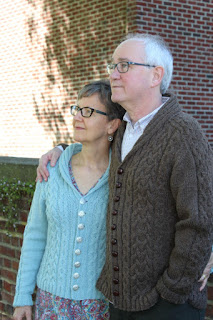Fair Isle, Part 2
My Oslo Star Hat took a turn.
I decided that the Citrus Tosh Merino Light would not do justice to the Golden Hickory of the same yarn, so I secured a skein of Glazed Pecan to work with the Golden Hickory instead. I got all the way into the colorwork portion (yes, past all that ribbing, and that's with cutting short the recommended 4-6" in order to fold the brim back, which I did not plan to do) and decided that there were too many places along the yarn that these two were the exact same color, which at times obscured the pattern entirely. I'm enjoying practicing two-handed color knitting, but not enough to have all my work hidden by poor color choice. High contrast was obviously the way to go, so I started all over again with this Manor and Grasshopper in Tosh Merino Light. Nice! My hat came out biggish because my gauge got all relaxey. I still like it.
But, I need to correct myself in calling the Oslo Star Hat a Fair Isle project. You'd think the name itself would have given me at least a hint, huh? I am learning so much with all of this, and one thing I've learned is that the Oslo Star Hat is Norwegian knitting, not Fair Isle. We who do not know enough about these things mistakenly call anything with more than one color going on Fair Isle (except stripes--we know that's not Fair Isle, right?) Let's get this straight. Fair Isle knitting is so much more than just throwing a couple of colors together, and Norwegian knitting has a rightful place all its own.
Here's one basic difference between the two. Norwegian knitting usually employs two colors at a time, and most of the time only those two colors. Sure, there may be hints of a third color here and there, but for most of the project, it's just two colors. Fair Isle usually employs two colors at a time, but those colors change and they change often.
I am learning that important fact first-hand with this Bauhaus Fair Isle Sweater designed by Mary Jane Mucklestone. As I told you in the post before last, I wanted to dig into my stash and try to use what I had for this sweater. Well, I got schooled!
Luckily, I had about half of the yarn for the sweater--two of the colors in the recommended Dale of Norway Heilo, the dark grey and some of the medium grey, and enough Dale Falk, another 100% wool yarn of the same weight, in the medium blue. Even though the pattern calls for navy blue, it works. I ordered more medium grey and light blue called for in the pattern and then stubbornly tried to sub in some Brown Sheep Nature Spun Sport in Bamboo for the olive and some Rowan Felted Tweed in a light grey. The pattern only calls for one skein of each--how bad could it be? It's not bad, but it's not good, either. For one thing, the Rowan is a wool/alpaca/viscose and I needed all wool. Now that I've read more about authentic Fair Isle, I know it needs to be not just any wool, but Shetland wool--good, scratchy, grabby wool. The stitches and floats need to sort of stick to one another to make a clean, firm fabric. There is also the promise of the bloom once it's blocked and dried. I want that!
So yesterday I ordered the two skeins of Heilo to make this sweater turn out right. I'll keep you posted.
While I'm waiting for the Heilo to come all the way from Minnesota (thanks to Laura at 3 Kittens because none of my local yarn shops have it), I thought I would finally allow myself to attend to this little package of Jamieson's 2-ply Shetland Spindrift in eight lovely colors. I bought these at a (since closed) local yarn shop years ago with the express purpose of designing a Fair Isle hat. Well, I'm itching to do just that, and to help me out, look what I found at a local book store--200 Fair Isle Motifs by the very same Mary Jane Mucklestone who designed the sweater I'm knitting. Perfect!
As I showed you last week, I have plenty of other books to help me plan this hat, but this one is even better. All of the motifs are shown actually knitted up, as well as in charts--black and white, color, and alternate color combinations. Mucklestone even shows you how to manipulate some of the patterns in different ways, like turning some of the border and motif patterns into allover patterns. The Fair Isle history section is fabulous, as are the technique, color choice, and designing sections. I (obviously) highly recommend this book if you want to learn Fair Isle knitting yourself.
As you see, I have my colors separated, with light on the left, dark on the right, and a couple of extra colors out to the sides to provide some pop. The pop colors should be brighter, but this time I'm going to allow myself to use what I have. At least they are all the very same yarn.
Sometimes it's okay to make do and sometimes it's not. You just have to know when!
That can be hard for a stubborn maker-doer like me. My granny taught me too well.
Now I'm off to play with some colors and Fair Isle patterns.
You have a nice day, too, and thanks for stopping by!




Comments